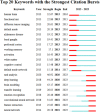Evolution Trend of Brain Science Research: An Integrated Bibliometric and Mapping Approach
- PMID: 40395088
- PMCID: PMC12092973
- DOI: 10.1002/brb3.70451
Evolution Trend of Brain Science Research: An Integrated Bibliometric and Mapping Approach
Abstract
Background: Brain science research is considered the crown jewel of 21st-century scientific research; the United States, the United Kingdom, and Japan have elevated brain science research to a national strategic level. This study employs bibliometric analysis and knowledge graph visualization to map global trends, research hotspots, and collaborative networks in brain science, providing insights into the field's evolving landscape and future directions.
Methods: We analyzed 13,590 articles (1990-2023) from the Web of Science Core Collection using CiteSpace and VOSviewer. Metrics included publication volume, co-authorship networks, citation patterns, keyword co-occurrence, and burst detection. Analytical tools such as VOSviewer, CiteSpace, and online bibliometric platforms were employed to facilitate this investigation.
Results: The United States, China, and Germany dominated research output, with China's publications rising from sixth to second globally post-2016, driven by national initiatives like the China Brain Project. However, China exhibited limited international collaboration compared to the United States and European Union. Key journals included Human Brain Mapping and Journal of Neural Engineering, while emergent themes centered on "task analysis," "deep learning," and "brain-computer interfaces" (BCIs). Research clusters revealed three focal areas: (1) Brain Exploration (e.g., fMRI, diffusion tensor imaging), (2) Brain Protection (e.g., stroke rehabilitation, amyotrophic lateral sclerosis therapies), and (3) Brain Creation (e.g., neuromorphic computing, BCIs integrated with AR/VR). Despite China's high output, its influence lagged in highly cited scholars, reflecting a "quantity-over-quality" challenge.
Conclusion: Brain science research is in a golden period of development. This bibliometric analysis offers the first comprehensive review, encapsulating research trends and progress in brain science. It reveals current research frontiers and crucial directions, offering a strategic roadmap for researchers and policymakers to navigate countries when planning research layouts.
Keywords: bibliometrics; brain science; research hotspot.
© 2025 The Author(s). Brain and Behavior published by Wiley Periodicals LLC.
Conflict of interest statement
The authors declare no conflicts of interest.
Figures









Similar articles
-
Research hotspots and frontiers of machine learning in renal medicine: a bibliometric and visual analysis from 2013 to 2024.Int Urol Nephrol. 2025 Mar;57(3):907-928. doi: 10.1007/s11255-024-04259-3. Epub 2024 Oct 30. Int Urol Nephrol. 2025. PMID: 39472403 Review.
-
Recent trends in research on the role of cholesterol in leukemia: a bibliometric and visualization study.Front Immunol. 2025 Jan 23;16:1511827. doi: 10.3389/fimmu.2025.1511827. eCollection 2025. Front Immunol. 2025. PMID: 39917295 Free PMC article.
-
Research Trends in the Application of Artificial Intelligence in Oncology: A Bibliometric and Network Visualization Study.Front Biosci (Landmark Ed). 2022 Aug 31;27(9):254. doi: 10.31083/j.fbl2709254. Front Biosci (Landmark Ed). 2022. PMID: 36224012
-
Global research trends and focus on immunotherapy for endometrial cancer: a comprehensive bibliometric insight and visualization analysis (2012-2024).Front Immunol. 2025 Apr 8;16:1571800. doi: 10.3389/fimmu.2025.1571800. eCollection 2025. Front Immunol. 2025. PMID: 40264788 Free PMC article.
-
The published role of artificial intelligence in drug discovery and development: a bibliometric and social network analysis from 1990 to 2023.J Cheminform. 2025 May 8;17(1):71. doi: 10.1186/s13321-025-00988-4. J Cheminform. 2025. PMID: 40341055 Free PMC article.
References
-
- Aliakbaryhosseinabadi, S. , Dosen S., Savic A. M., Blicher J., Farina D., and Mrachacz‐Kersting N.. 2021. “Participant‐Specific Classifier Tuning Increases the Performance of Hand Movement Detection From EEG in Patients With Amyotrophic Lateral Sclerosis.” Journal of Neural Engineering 18, no. 5: 056023. 10.1088/1741-2552/ac15e3. - DOI - PubMed
-
- Aristela de Freitas, Zanona , Piscitelli D., Seixas V. M., et al. 2023. “Brain–Computer Interface Combined With Mental Practice and Occupational Therapy Enhances Upper Limb Motor Recovery, Activities of Daily Living, and Participation in Subacute Stroke.” Frontiers in Neurology 13: 1041978. 10.3389/fneur.2022.1041978. - DOI - PMC - PubMed
-
- Bermudez I Badia, S. , Garcia Morgade A., Samaha H., and Verschure P. F. M. J.. 2013. “Using a Hybrid Brain–Computer Interface and Virtual Reality System to Monitor and Promote Cortical Reorganization Through Motor Activity and Motor Imagery Training.” IEEE Transactions on Neural Systems and Rehabilitation Engineering 21, no. 2: 174–181. 10.1109/TNSRE.2012.2229295. - DOI - PubMed
Publication types
MeSH terms
Grants and funding
- 2020Z388/Jiangsu Postdoctoral Research Foundation
- Top Talent Support Program for young and middle-aged people of the Wuxi Health Committee
- M202033/Wuxi Health Commission Scientific Research Project
- 24CC00903/Beijing Academy of Science and Technology Think Tank Research Project
- ZYYB05/Wuxi Administration of Traditional Chinese Medicine
LinkOut - more resources
Full Text Sources
Research Materials

